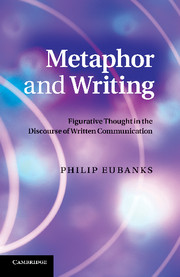Book contents
- Frontmatter
- Contents
- List of figures
- List of tables
- Acknowledgements
- Introduction
- 1 In search of the figurative rhetoric of writing
- 2 The double bind of writer and to write: Graded categories
- 3 Bind upon bind: The general-ability and the specific-expertise views of writing
- 4 Three licensing stories: The literate inscriber, the good writer, and the author writer
- 5 Writing as transcription, talk, and voice: A complex metonymy
- 6 The writing self: Conceptual blends, multiple selves
- 7 Writing to “get ideas across”: The role of the Conduit Metaphor
- 8 Codes and conversations: The other Conduit Metaphor
- 9 Metaphor and choice
- References
- Index
1 - In search of the figurative rhetoric of writing
Published online by Cambridge University Press: 06 December 2010
- Frontmatter
- Contents
- List of figures
- List of tables
- Acknowledgements
- Introduction
- 1 In search of the figurative rhetoric of writing
- 2 The double bind of writer and to write: Graded categories
- 3 Bind upon bind: The general-ability and the specific-expertise views of writing
- 4 Three licensing stories: The literate inscriber, the good writer, and the author writer
- 5 Writing as transcription, talk, and voice: A complex metonymy
- 6 The writing self: Conceptual blends, multiple selves
- 7 Writing to “get ideas across”: The role of the Conduit Metaphor
- 8 Codes and conversations: The other Conduit Metaphor
- 9 Metaphor and choice
- References
- Index
Summary
By examining and extending student metaphors for composing, we gain valuable information not only about how students struggle with themselves to create a text but also how they struggle with their writing teacher over issues of power and authority.
Lad Tobin, “Bridging gaps: analyzing student metaphors for composing”In this essay, I want to propose a shift away from such metaphors of territory and towards reconceiving rhetoric as something more like travel. What would change if we were to make such a shift? One thing that would change is our general understanding of the social context in which written texts have communicative function.
Gregory Clark, “Writing as travel, or rhetoric on the road”Obviously, post-process theories that insist upon the radically situated nature of writing seem to embrace the conceptual metaphor of chaos rather than narrow conceptualizations of orderly writing (sometimes called “academic writing” as though there existed a single model for such artifacts).
Bonnie Lenore Kyburz, “Meaning finds a way: chaos (theory) and composition”In the face of this negative history of grammatical mechanics in composition studies, therefore, I would like to suggest the mechanic as a figure for thinking about rhetoric and writing.
Jenny Edbauer Rice, “Rhetoric's mechanics: retooling the equipment of writing production”Writing studies has long recognized the essential role of metaphor in shaping what we think about writing. In that sense, what I offer here is an addendum to an uncontroversial conclusion: If we want to think more carefully about who writers are, what writing is, and how writing affects our lives, we should pay attention to our figurative language and thought.
- Type
- Chapter
- Information
- Metaphor and WritingFigurative Thought in the Discourse of Written Communication, pp. 13 - 25Publisher: Cambridge University PressPrint publication year: 2010

